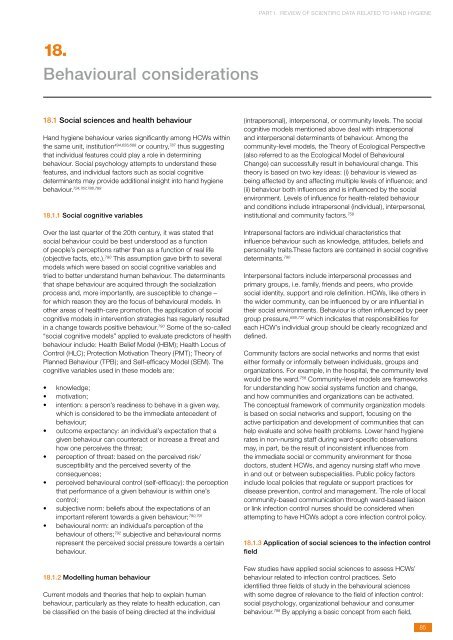WHO Guidelines on Hand Hygiene in Health Care - Safe Care ...
WHO Guidelines on Hand Hygiene in Health Care - Safe Care ...
WHO Guidelines on Hand Hygiene in Health Care - Safe Care ...
You also want an ePaper? Increase the reach of your titles
YUMPU automatically turns print PDFs into web optimized ePapers that Google loves.
PART I. REVIEW OF SCIENTIFIC DATA RELATED TO HAND HYGIENE<br />
18.<br />
Behavioural c<strong>on</strong>siderati<strong>on</strong>s<br />
18.1 Social sciences and health behaviour<br />
<strong>Hand</strong> hygiene behaviour varies significantly am<strong>on</strong>g HCWs with<strong>in</strong><br />
the same unit, <strong>in</strong>stituti<strong>on</strong> 494,656,688 or country, 787 thus suggest<strong>in</strong>g<br />
that <strong>in</strong>dividual features could play a role <strong>in</strong> determ<strong>in</strong><strong>in</strong>g<br />
behaviour. Social psychology attempts to understand these<br />
features, and <strong>in</strong>dividual factors such as social cognitive<br />
determ<strong>in</strong>ants may provide additi<strong>on</strong>al <strong>in</strong>sight <strong>in</strong>to hand hygiene<br />
behaviour. 724,767,788,789<br />
18.1.1 Social cognitive variables<br />
Over the last quarter of the 20th century, it was stated that<br />
social behaviour could be best understood as a functi<strong>on</strong><br />
of people’s percepti<strong>on</strong>s rather than as a functi<strong>on</strong> of real life<br />
(objective facts, etc.). 790 This assumpti<strong>on</strong> gave birth to several<br />
models which were based <strong>on</strong> social cognitive variables and<br />
tried to better understand human behaviour. The determ<strong>in</strong>ants<br />
that shape behaviour are acquired through the socializati<strong>on</strong><br />
process and, more importantly, are susceptible to change –<br />
for which reas<strong>on</strong> they are the focus of behavioural models. In<br />
other areas of health-care promoti<strong>on</strong>, the applicati<strong>on</strong> of social<br />
cognitive models <strong>in</strong> <strong>in</strong>terventi<strong>on</strong> strategies has regularly resulted<br />
<strong>in</strong> a change towards positive behaviour. 790 Some of the so-called<br />
“social cognitive models” applied to evaluate predictors of health<br />
behaviour <strong>in</strong>clude: <strong>Health</strong> Belief Model (HBM); <strong>Health</strong> Locus of<br />
C<strong>on</strong>trol (HLC); Protecti<strong>on</strong> Motivati<strong>on</strong> Theory (PMT); Theory of<br />
Planned Behaviour (TPB); and Self-efficacy Model (SEM). The<br />
cognitive variables used <strong>in</strong> these models are:<br />
• knowledge;<br />
• motivati<strong>on</strong>;<br />
• <strong>in</strong>tenti<strong>on</strong>: a pers<strong>on</strong>’s read<strong>in</strong>ess to behave <strong>in</strong> a given way,<br />
which is c<strong>on</strong>sidered to be the immediate antecedent of<br />
behaviour;<br />
• outcome expectancy: an <strong>in</strong>dividual’s expectati<strong>on</strong> that a<br />
given behaviour can counteract or <strong>in</strong>crease a threat and<br />
how <strong>on</strong>e perceives the threat;<br />
• percepti<strong>on</strong> of threat: based <strong>on</strong> the perceived risk/<br />
susceptibility and the perceived severity of the<br />
c<strong>on</strong>sequences;<br />
• perceived behavioural c<strong>on</strong>trol (self-efficacy): the percepti<strong>on</strong><br />
that performance of a given behaviour is with<strong>in</strong> <strong>on</strong>e’s<br />
c<strong>on</strong>trol;<br />
• subjective norm: beliefs about the expectati<strong>on</strong>s of an<br />
important referent towards a given behaviour; 790,791<br />
• behavioural norm: an <strong>in</strong>dividual’s percepti<strong>on</strong> of the<br />
behaviour of others; 792 subjective and behavioural norms<br />
represent the perceived social pressure towards a certa<strong>in</strong><br />
behaviour.<br />
18.1.2 Modell<strong>in</strong>g human behaviour<br />
Current models and theories that help to expla<strong>in</strong> human<br />
behaviour, particularly as they relate to health educati<strong>on</strong>, can<br />
be classified <strong>on</strong> the basis of be<strong>in</strong>g directed at the <strong>in</strong>dividual<br />
(<strong>in</strong>trapers<strong>on</strong>al), <strong>in</strong>terpers<strong>on</strong>al, or community levels. The social<br />
cognitive models menti<strong>on</strong>ed above deal with <strong>in</strong>trapers<strong>on</strong>al<br />
and <strong>in</strong>terpers<strong>on</strong>al determ<strong>in</strong>ants of behaviour. Am<strong>on</strong>g the<br />
community-level models, the Theory of Ecological Perspective<br />
(also referred to as the Ecological Model of Behavioural<br />
Change) can successfully result <strong>in</strong> behavioural change. This<br />
theory is based <strong>on</strong> two key ideas: (i) behaviour is viewed as<br />
be<strong>in</strong>g affected by and affect<strong>in</strong>g multiple levels of <strong>in</strong>fluence; and<br />
(ii) behaviour both <strong>in</strong>fluences and is <strong>in</strong>fluenced by the social<br />
envir<strong>on</strong>ment. Levels of <strong>in</strong>fluence for health-related behaviour<br />
and c<strong>on</strong>diti<strong>on</strong>s <strong>in</strong>clude <strong>in</strong>trapers<strong>on</strong>al (<strong>in</strong>dividual), <strong>in</strong>terpers<strong>on</strong>al,<br />
<strong>in</strong>stituti<strong>on</strong>al and community factors. 758<br />
Intrapers<strong>on</strong>al factors are <strong>in</strong>dividual characteristics that<br />
<strong>in</strong>fluence behaviour such as knowledge, attitudes, beliefs and<br />
pers<strong>on</strong>ality traits.These factors are c<strong>on</strong>ta<strong>in</strong>ed <strong>in</strong> social cognitive<br />
determ<strong>in</strong>ants. 790<br />
Interpers<strong>on</strong>al factors <strong>in</strong>clude <strong>in</strong>terpers<strong>on</strong>al processes and<br />
primary groups, i.e. family, friends and peers, who provide<br />
social identity, support and role def<strong>in</strong>iti<strong>on</strong>. HCWs, like others <strong>in</strong><br />
the wider community, can be <strong>in</strong>fluenced by or are <strong>in</strong>fluential <strong>in</strong><br />
their social envir<strong>on</strong>ments. Behaviour is often <strong>in</strong>fluenced by peer<br />
group pressure, 688,732 which <strong>in</strong>dicates that resp<strong>on</strong>sibilities for<br />
each HCW’s <strong>in</strong>dividual group should be clearly recognized and<br />
def<strong>in</strong>ed.<br />
Community factors are social networks and norms that exist<br />
either formally or <strong>in</strong>formally between <strong>in</strong>dividuals, groups and<br />
organizati<strong>on</strong>s. For example, <strong>in</strong> the hospital, the community level<br />
would be the ward. 758 Community-level models are frameworks<br />
for understand<strong>in</strong>g how social systems functi<strong>on</strong> and change,<br />
and how communities and organizati<strong>on</strong>s can be activated.<br />
The c<strong>on</strong>ceptual framework of community organizati<strong>on</strong> models<br />
is based <strong>on</strong> social networks and support, focus<strong>in</strong>g <strong>on</strong> the<br />
active participati<strong>on</strong> and development of communities that can<br />
help evaluate and solve health problems. Lower hand hygiene<br />
rates <strong>in</strong> n<strong>on</strong>-nurs<strong>in</strong>g staff dur<strong>in</strong>g ward-specific observati<strong>on</strong>s<br />
may, <strong>in</strong> part, be the result of <strong>in</strong>c<strong>on</strong>sistent <strong>in</strong>fluences from<br />
the immediate social or community envir<strong>on</strong>ment for those<br />
doctors, student HCWs, and agency nurs<strong>in</strong>g staff who move<br />
<strong>in</strong> and out or between subspecialities. Public policy factors<br />
<strong>in</strong>clude local policies that regulate or support practices for<br />
disease preventi<strong>on</strong>, c<strong>on</strong>trol and management. The role of local<br />
community-based communicati<strong>on</strong> through ward-based liais<strong>on</strong><br />
or l<strong>in</strong>k <strong>in</strong>fecti<strong>on</strong> c<strong>on</strong>trol nurses should be c<strong>on</strong>sidered when<br />
attempt<strong>in</strong>g to have HCWs adopt a core <strong>in</strong>fecti<strong>on</strong> c<strong>on</strong>trol policy.<br />
18.1.3 Applicati<strong>on</strong> of social sciences to the <strong>in</strong>fecti<strong>on</strong> c<strong>on</strong>trol<br />
field<br />
Few studies have applied social sciences to assess HCWs’<br />
behaviour related to <strong>in</strong>fecti<strong>on</strong> c<strong>on</strong>trol practices. Seto<br />
identified three fields of study <strong>in</strong> the behavioural sciences<br />
with some degree of relevance to the field of <strong>in</strong>fecti<strong>on</strong> c<strong>on</strong>trol:<br />
social psychology, organizati<strong>on</strong>al behaviour and c<strong>on</strong>sumer<br />
behaviour. 788 By apply<strong>in</strong>g a basic c<strong>on</strong>cept from each field,<br />
85















